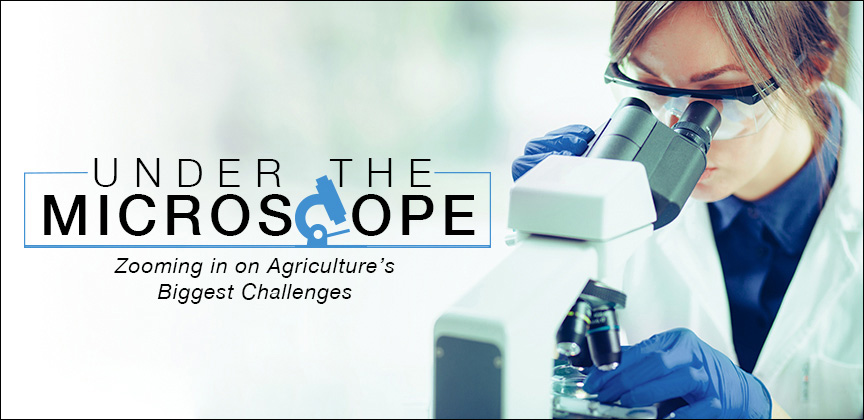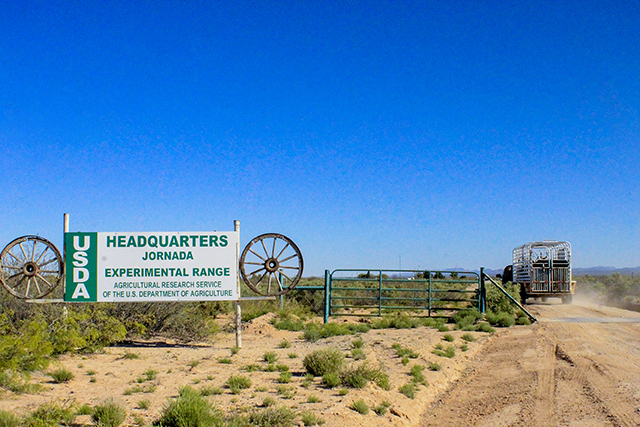
Improving Rangeland Resilience in the Southwest Climate Hub
 |
Dr. Emile Elias is the Director of the USDA Southwest Climate Hub. Her work involves investigations into the effects of climate change on hydrology, water quality, and agricultural communities in the southwestern U.S. Dr. Sheri Spiegal is the co-director of the Sustainable Southwest Beef Coordinated Agricultural Project. Her research focuses on the improvement and sustainability of agricultural systems in the southwestern U.S., especially through the recycling of resources within the supply chain. |
Welcome Drs. Elias and Spiegal to Under the Microscope.
UM – What are climate hubs and what do they do?
EE – USDA's Climate Hubs develop and deliver science-based, region-specific information and technologies so that agricultural and natural resource land managers are empowered to make climate-informed decisions.
Because agriculture is so region-based, Climate Hubs were created across the country (and in Puerto Rico) to address specific issues and challenges in each respective region.
You can find out more about the USDA Climate Hubs and program goals here.
UM – Developing sustainable agricultural systems and practices is one of USDA’s major goals. What makes a rangeland environment sustainable and resilient?
SS – This is a great question! In many ways, sustainability is in the eye of the beholder, and for USDA, in the eye of the stakeholder. For instance, while some stakeholders believe that grazing on rangelands is the best way to protect these extensive landscapes from conversion to more intensive uses, others believe sustainability can be achieved only if livestock grazing is removed entirely.
So, looking across perspectives, sustainable rangelands are not only places where ecosystem processes are thriving, but also places where agricultural production and rural economies are thriving, as well.
 Stretching over an expanse of more than 300 square miles, the USDA-ARS Jornada Experimental Range in Las Cruces, NM focuses on long-term research into effective rangeland management and healthy desert ecosystems.
Stretching over an expanse of more than 300 square miles, the USDA-ARS Jornada Experimental Range in Las Cruces, NM focuses on long-term research into effective rangeland management and healthy desert ecosystems.
UM – How is climate change currently affecting the rangelands in the southwest?
EE – Some of the predicted consequences of climate change on rangelands systems include changes in soil carbon content (due to temperature and precipitation), wildfire patterns, water and wind erosion, plant community composition, and even the expansion of invasive species. All of these shifts impact livestock production systems and forage quality/quantity. Recent trends and model projections indicate that the warming and drying will continue to reduce soil water availability, productivity, and other ecosystem processes in the Southwest.
According to the U.S. Drought Monitor, as of April 6, 2021, almost all of the Southwestern U.S. is in some level of drought, with large percentages of Utah, Arizona, New Mexico, and Nevada in exceptional drought, the most severe drought category. The southwestern US is experiencing longer and more severe drought conditions that in the past.
UM – How are farmers and ranchers adjusting to meet the challenges of today?
EE – Fortunately, novel solutions are emerging to help farmers and ranchers adjust to meet these challenges. Monitoring and precision technologies – including cameras and sensors for dust monitoring, cattle tracking, trough water surveillance, and precipitation variability monitoring – hold a lot of potential.
Agrivoltaics (producing solar energy in combination with agricultural enterprise and dual land uses, such as wind energy or bioenergy) are also creative options for farmers and ranchers looking for non-traditional revenue streams and reduced reliance on traditional energy sources.
![]() Precision ranching technologies like tracking collars (orange device) help ranchers and scientists closely monitor cattle movements across vast tracts of land. (Photo by Matthew M. McIntosh, New Mexico State University)
Precision ranching technologies like tracking collars (orange device) help ranchers and scientists closely monitor cattle movements across vast tracts of land. (Photo by Matthew M. McIntosh, New Mexico State University)
UM – What types of challenges do members of the beef production industry currently face?
SS – The U.S. beef industry is experiencing new opportunities, such as growing demand for beef worldwide and increasing domestic demand for beef that is perceived to be environmentally friendly. Yet to meet these demand opportunities, ranchers are expected to increase productivity without compromising environmental quality – all the while battling the intensifying impacts of climate change, such as diminished rangeland carrying capacities, increased vulnerability to soil degradation, compromised feed/pasture/forage production, and intensified animal heat stress.
UM – The Southwest Climate Hub is part of a collaborative effort called the Sustainable Southwest Beef Coordinated Agriculture Project (CAP). Please explain the project’s goals.
SS – The Sustainable Southwest Beef Coordinated Agriculture Project (CAP) is a 5-year project that promotes ranch and rangeland resilience in the western US. The team is evaluating heritage cattle genetics, precision ranching technologies, and supply chain options as strategies to help keep ranching and rangelands ecologically and economically healthy as climate, markets, and policies change.
It’s an integrated project, with research, extension, and education pillars. The main goal is to integrate these activities to truly understand the problems the producers are facing, whether these novel strategies are viable solutions to the problems, and how students – the producers and policy-makers of tomorrow – perceive sustainability challenges and solutions.

Being researched for their capacity to be ‘desert-friendly,’ Criollo cattle are smaller but hardier than most conventionally bred cattle in the American beef industry. (Photo by Matthew M. McIntosh, New Mexico State University)
UM – You mentioned that CAP is implementing novel precision technologies to optimize efficiency on ranches. What types of techniques and systems have been successful in doing so?
SS – Precision ranching is the use of smart sensors for the automated monitoring of livestock, watering troughs, rainfall, and forage growth. While precision systems are used relatively rarely in ranching operations, in part due to lack of available technologies, the technology is quickly expanding and becoming more cost-effective. CAP is contributing to this new knowledge base, developing and testing tracking collars for cattle, water level sensors, fine-scale precipitation monitoring, and virtual fencing.
We pay close attention to the costs of adopting new precision systems, as margins are famously thin across the ranching industry. We’ll test these tools and examine their costs – if promising, we’ll also provide a roadmap for ranchers to adopt the systems.
UM – How will cattle production become more efficient in the future, while at the same time adjusting to a changing climate?
EE – Well, we can’t exactly predict the future, but if we look at how precision agriculture has changed and improved the way farmers manage their field crops - from irrigation to fertilizer applications – we have reason to believe that technologies adapted to increase efficiency in extensive rangeland systems might have a similar impact.
SS – With climate change and generally rising temperatures, heat stress in cattle is another challenge to overcome in the Southwest. Fortunately, we have some evidence that Raramuri Criollo cattle, a breed indigenous to the U.S.-Mexico border region, tolerate heat better than some of the more conventionally bred cattle breeds in the southwestern U.S. The Raramuri Criollo are also hardier, can travel greater distances while grazing, and require less water.
Ensuring that cattle are better adapted to their environment will improve producers’ overall efficiency and also help them meet consumer demand in an environmentally and economically sustainable manner. – by Georgia Jiang, ARS Office of Communications.
